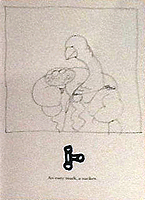This book claims to have 52 hobo signs illustrated in it however there are only 51 hobo signs.
These signs can be found in our
Hobo signs database page by searching Stan Richards
Hobo Signs
A lament of the demise of
the most communicative symbolism of them all
Sometime chalked on curbs and sidewalks or appearing as tiny pencil marks on doorfacings or mailboxes and gates, hobo signs served as a guide to anyone who knew the code, steering them away from discomfort and danger and pointing the way to good food and a feather bed.
The Gypsies of Europse are responsible for most of the hobos' private Language - becuase of their unique position as a formal nation of bagabonds.
As such they were able to assign uniform menaings to the various symbols and to enforce those meanings long enough for them to solidify. Drawn largely from the symbolism of medeval magic and the mystic alphabet of the Cabala, these signs have been in widespread use even in America until recent times of general affluence.
There are thousands of hobo signs for thousands of occasions. We have included fifty-two of them on the following pages.

This page of the book illustrates some basic signs:
Two Diamonds: Keep quiet (warns of day sleepers, babies)
Right Horseshoe: The owner is in
Left Horseshoe: The owner is out
2/10: There are thieves about
Two cresents: A dishonest person lives here

Under the illustration of some sort of bird
A T-Pipe: An easy mark, a sucker
